Address any questions or comments regarding this newsletter to the individual authors listed after each article or to its editors, Nathan Johanning, 618-939-3434, njohann@illinois.edu or Bronwyn Aly 618-695-6060, baly@illinois.edu. The Illinois Fruit and Vegetable News is available on the web at: http://ipm.illinois.edu/ifvn/. To receive or be removed from email notification of new postings of this newsletter, contact Nathan Johanning or Bronwyn Aly at the phone numbers or email addresses above.
In This Issue:
Upcoming programs (listings for beginning and established growers)
News & Announcements (Illinois Local Food Changemakers of the Year, USDA Accepting Applications to Help Cover Costs for Organic Certification, USDA Revises Standards for Watermelons, USDA Updates Pandemic Assistance for a Variety of Producers)
Regional Reports (St. Louis metro east, southwestern Illinois (Waterloo), southern Illinois (Murphysboro), Dixon Springs)
Fruit & Vegetable Production & Pest Management (Warm, Humid in the Midwest, EPA Issues Final Ruling on Use of Chlorpyrifos)
Upcoming programs
See the University of Illinois Extension Local Food Systems and Small Farms Team’s website at:
http://web.extension.illinois.edu/smallfarm/ and the calendar of events at http://web.extension.illinois.edu/units/calendar.cfm?UnitID=629.
- The Great Lakes Fruit, Vegetable & Farm Market Expo (GLEXPO) is returning to its traditional face-to-face format, and will be held December 7-9, 2021 at the DeVos Place in Grand Rapids, Michigan. Registration for the program itself will be coming at a later date, but you should make your room reservations now as hotels near the conference site tend to fill up quickly. Visit their website for additional details as they become available at https://glexpo.com/expo-schedule/ or visit their Facebook page at https://www.facebook.com/GLExpo/
- Save the Date! The Illinois Specialty Crops Conference is also returning to a face-to-face format January 5-7 at the Springfield Crowne Plaza. Our program team is well on their way to providing another great program, so we should have program details available in the coming months.
News & Announcements
USDA Accepting Applications to Help Cover Costs for Organic Certification
SPRINGFIELD, Illinois, August 25, 2021 – Organic producers and handlers can now apply for U.S. Department of Agriculture (USDA) funds to assist with the cost of receiving or maintaining organic certification. Applications for the Organic Certification Cost Share Program (OCCSP) are due November 1, 2021.
“USDA is here to help all producers, including those who grow our nation’s organic food and fiber. Many farmers have told us that cost was a barrier to their ability to get an organic certification,” said Zach Ducheneaux, administrator of USDA’s Farm Service Agency (FSA). “By assisting with the costs, this program can help organic farmers get their certification along with the benefits thatcome with it.”
OCCSP provides cost-share assistance to producers and handlers of agricultural products for the costs of obtaining or maintaining organic certification under the USDA’s National Organic Program. Eligible producers include any certified producers or handlers who have paid organic certification fees to a USDA-accredited certifying agent during the 2021 and any subsequent program year. Producers can be reimbursed for expenses made between October 1, 2020 and September 30, 2021 including application fees, inspection costs, fees related to equivalency agreement and arrangement requirements, travel expenses for inspectors, user fees, sales assessments and postage.
For 2021, OCCSP will reimburse 50% of a certified operation’s allowable certification costs, up to a maximum of $500 for each of the following categories (or “scopes”):
- crops
- wild crops
- livestock
- processing/handling
- State organic program fees.
Organic farmers and ranchers may apply through an FSA county office or a participating state agency.
This funding will be complemented by an additional $20 million for organic and transitioning producers through the Pandemic Assistance for Producers initiative. More information on that funding will be available in the coming weeks.
To learn more about organic certification cost share, please visit the OCCSP webpage, visit usda.gov/organic, or contact your local USDA Service Center.
In the Biden-Harris Administration, USDA is transforming America’s food system with a greater focus on more resilient local and regional food production, fairer markets for all producers, ensuring access to safe, healthy and nutritious food in all communities, building new markets and streams of income for farmers and producers using climate smart food and forestry practices, making historic investments in infrastructure and clean energy capabilities in rural America, and committing to equity across the Department by removing systemic barriers and building a workforce more representative of America. To learn more, visit http://www.usda.gov.
USDA is an equal opportunity provider, employer and lender.
USDA Revises U.S. Standards For Watermelon
Several revisions to the standards will become effective on September 20, 2021
PUBLISHED ON AUGUST 22, 202
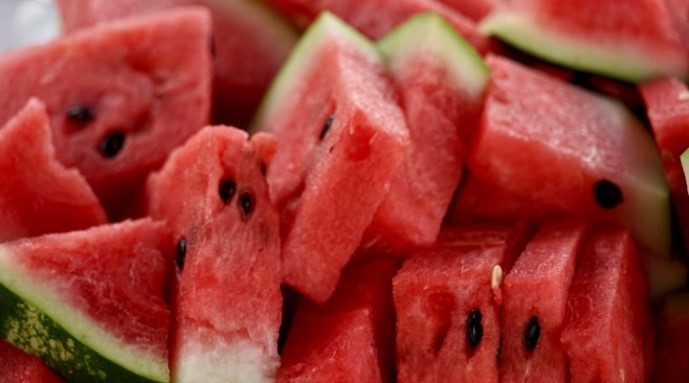
AMS is adjusting the range of average weight from 20-42 to 10-34 pounds to align with current marketing trends. (Photo by Floh Maier on Unsplash)
WASHINGTON — The U.S. Department of Agriculture (USDA) Agricultural Marketing Service (AMS) is revising the U.S. Standards for Watermelon to provide a common language for trade.
AMS is establishing a total tolerance for Anthracnose and decay in the U.S. No. 1 and U.S. No. 2 grades; adjusting the range of average weight from 20-42 to 10-34 pounds to align with current marketing trends; adding sunburn as a permanent defect; revising scoring guides for hail, rind worm injury, scars, hollow heart, sunburn, and transit rubs; removing metric measurements from the standard; and making minor editorial changes.
The revisions were published in the Federal Register on August 19, 2021, and become effective on September 20, 2021.Copies of the current U.S. Standards for Grades of Watermelon are available on the AMS website.
For more information, contact David Horner at 540-361-1128 or Dave.Horner@usda.gov.
USDA AMS
USDA Updates Pandemic Assistance For A Variety Of Producers
Assistance available for livestock, poultry contract producers and specialty crop growers
PUBLISHED ON AUGUST 25, 2021
WASHINGTON — The U.S. Department of Agriculture (USDA) is updating the Coronavirus Food Assistance Program 2 (CFAP 2) for contract producers of eligible livestock and poultry and producers of specialty crops and other sales-based commodities. CFAP 2, which assists producers who faced market disruptions in 2020 due to COVID-19, is part of USDA’s broader Pandemic Assistance for Producers initiative. Additionally, USDA’s Farm Service Agency (FSA) has set an Oct. 12 deadline for all eligible producers to apply for or modify applications for CFAP 2.
“We listened to feedback and concerns from producers and stakeholders about the gaps in pandemic assistance, and these adjustments to CFAP 2 help address unique circumstances, provide flexibility and make the program more equitable for all producers,” said FSA Administrator Zach Ducheneaux. “The pandemic has had a tremendous impact on agricultural producers, and we have made significant progress since announcing our plans in March. While additional pandemic assistance remains to be announced in the coming weeks, USDA is also ramping up its efforts to make investments in the food supply chain to Build Back Better.”
Assistance for Contract Producers
The Consolidated Appropriations Act, 2021, provides up to $1 billion for payments to contract producers of eligible livestock and poultry for revenue losses from Jan. 1, 2020, through Dec. 27, 2020. Contract producers of broilers, pullets, layers, chicken eggs, turkeys, hogs and pigs, ducks, geese, pheasants and quail may be eligible for assistance. This update includes eligible breeding stock and eggs of all eligible poultry types produced under contract.
Payments for contract producers were to be based on a comparison of eligible revenue for the periods of Jan. 1, 2019, through Dec. 27, 2019, and Jan. 1, 2020, through Dec. 27, 2020. Today’s changes mean contract producers can now elect to use eligible revenue from the period of Jan. 1, 2018, through Dec. 27, 2018, instead of that date range in 2019 if it is more representative. This change is intended to provide flexibility and make the program more equitable for contract producers who had reduced revenue in 2019 compared to a normal production year. The difference in revenue is then multiplied by 80% to determine a final payment. Payments to contract producers may be factored if total calculated payments exceed the available funding and will be made after the application period closes.
Additional flexibilities have been added to account for increases to operation size in 2020 and situations where a contract producer did not have a full period of revenue from Jan. 1 to Dec. 27 for either 2018 or 2019. Assistance is also available to new contract producers who began their farming operation in 2020.
Updates for Sales-Based Commodities
USDA is amending the CFAP 2 payment calculation for sales-based commodities, which are primarily comprised of by specialty crops, to allow producers to substitute 2018 sales for 2019 sales. Previously, payments for producers of sales-based commodities were based only on 2019 sales, with 2019 used as an approximation of the amount the producer would have expected to market in 2020. Giving producers the option to substitute 2018 sales for this approximation, including 2018 crop insurance indemnities and 2018 crop year Noninsured Disaster Assistance Program (NAP) and Wildfire and Hurricane Indemnity Program Plus (WHIP+) payments, provides additional flexibility to producers of sales-based commodities who had reduced sales in 2019.
Grass seed has also been added as an eligible sales commodity for CFAP 2. A complete list of all eligible sales-based commodities can be found at farmers.gov/cfap2/commodities. Producers of sales-based commodities can modify existing applications.
Applying for Assistance
Sign-up for CFAP 2 was re-opened in March and remains open to address inadequate initial outreach efforts to reach underserved producers and particularly those who produce sales commodities. Newly eligible producers who need to submit a CFAP 2 application or producers who need to modify an existing one can do so by contacting their local FSA office. Producers can find their local FSA office by visiting farmers.gov/service-locator. Producers can also obtain one-on-one support with applications by calling 877-508-8364. All new and modified CFAP 2 applications are due by the Oct. 12 deadline.
As USDA looks to long-term solutions to build back a better food system as announced in June, the Department is committed to delivery of financial assistance to farmers, ranchers and agricultural producers and businesses who have been impacted by COVID-19 market disruptions. Since USDA rolled out the Pandemic Assistance for Producers initiative in March, the Department has announced approximately $7 billion in assistance to producers and agriculture entities. Previously announced pandemic assistance has included:
- Additional dairy assistance related to market volatility
- Depopulated livestock and poultry
- Timber harvesting and hauling
- $1 billion to purchase healthy food for food insecure Americans and build food bank capacity
- Pandemic Cover Crop Program
- $500 million deployed through existing USDA programs
For more details, please visit www.farmers.gov/pandemic-assistance.
USDA touches the lives of all Americans each day in so many positive ways. In the Biden-Harris Administration, USDA is transforming America’s food system with a greater focus on more resilient local and regional food production, fairer markets for all producers, ensuring access to healthy and nutritious food in all communities, building new markets and streams of income for farmers and producers using climate smart food and forestry practices, making historic investments in infrastructure and clean energy capabilities in rural America, and committing to equity across the Department by removing systemic barriers and building a workforce more representative of America. To learn more, visit www.usda.gov. USDA is an equal opportunity provider, employer and lender.
–USDA
Regional Reports
St. Louis metro east… The region is in the transition period when both peaches and apples are in harvest together. Peach harvest is in the Cresthaven window, including cultivars like PF 28-007, Jerseyglo, Messina, and Gloria. Color picking of Gala apple has started, with Honeycrisp not far behind. The blackberry season is coming to a close. Soil fumigation and plastic laying is ongoing in preparation for late August – early September planting of strawberries. Conditions have been good for pumpkin growth, and evening temperatures have been cooler, favoring production of female flowers. One grower commented 50% of their planting was now specialty pumpkins in response to an increased consumer demand. The downside was less disease resistance in the specialty pumpkins as a whole compared to the Jack-o-lantern types, so disease management was a priority. Tomatoes are still in full production, though still slow to ripen following a recent hot spell.
Elizabeth Wahle (618-344-4230; wahle@illinois.edu)
From southern Illinois (Murphysboro)… Summer harvests continue here at the Jackson County Extension office. We are currently up to our sixth harvest on the tomato fertility trial. Our last harvest has been our largest so far, yielding almost 150 pounds of marketable tomatoes. Over 800 lbs of marketable fruit have been harvested from the trial across 6 harvests. We are noticing some coring differences, especially in the plants that received only nitrogen fertilizer and the lower potassium rate applied.
We have had several office tours and programs this summer, including an herb program and grounds tour. The high tunnel is full of fall crops that will be going out into the raised beds, including brussels sprouts, spinach, and various lettuces. The demonstration pumpkin field has many small ornamental gourds, specialty pumpkins, and large jack o’ lanterns on the vine. Our cut flower field is still in full bloom and has attracted a lot of pollinators this summer.
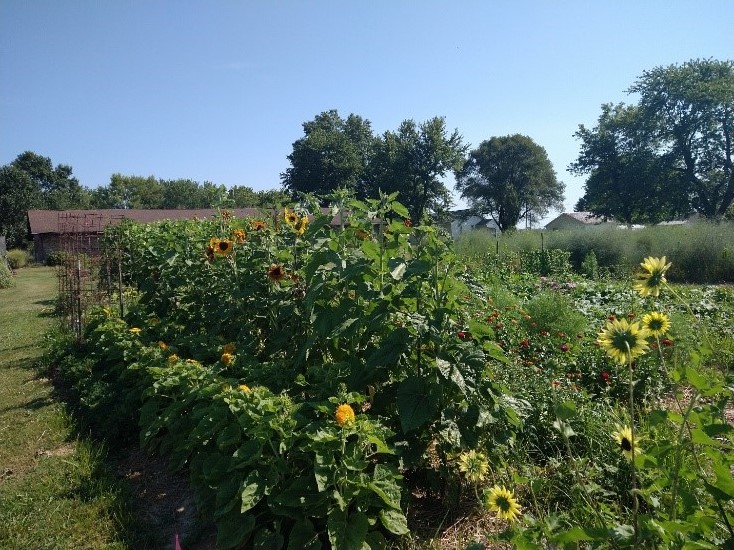
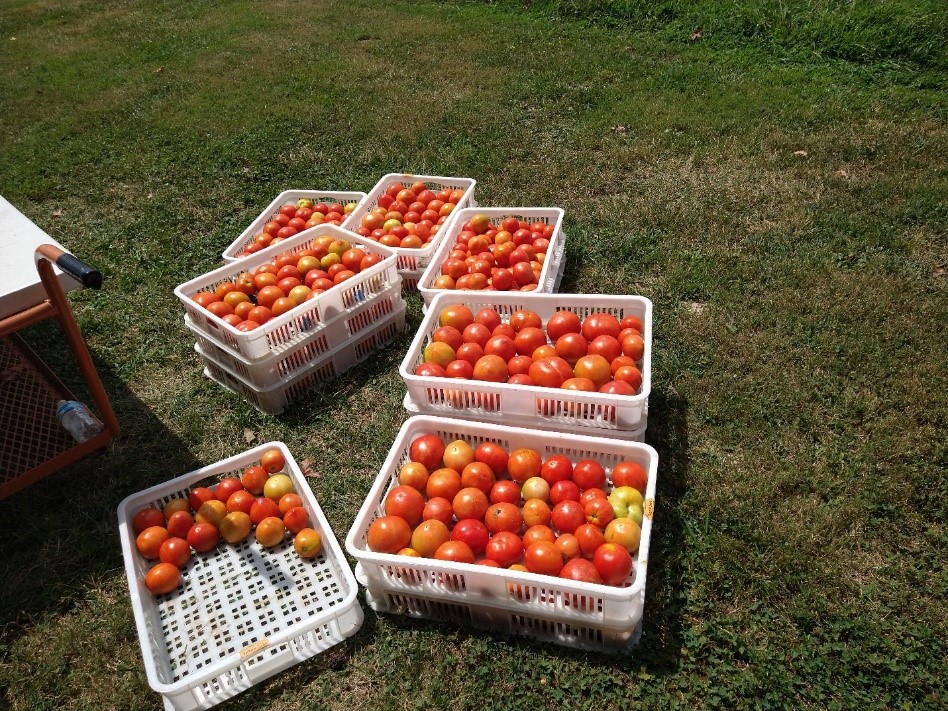
Cut flower patch (left) and marketable tomato fruit collected from tomato fertility trial (right) from Jackson Co. Extension office. Photos by K. Bell.
As always have a happy and safe 2021 growing season!
Katie Bell (618-687-1727; klbell@illinois.edu)
From Dixon Springs Ag Center…The weather this past month seems to be on a bit of a rollercoaster. We had a week or so of really terrific temperatures (low to mid 80s) with lower humidity that gave our cucumbers, tomatoes, and strawberries in the high tunnels a nice breather and kickstarted new growth. But the last couple of weeks have been back to normal to above normal temperatures and humidity, with heat indexes reaching 108-110 degrees F the last few days, making daily chores feel pretty soggy. We are continuing with harvests on tomatoes in the fertility study and plants are continuing to set and size more fruit. This last couple of weeks have yielded quite a bit of peppers from our various plots, including sweet snacking peppers, banana peppers, poblano peppers and bell peppers.
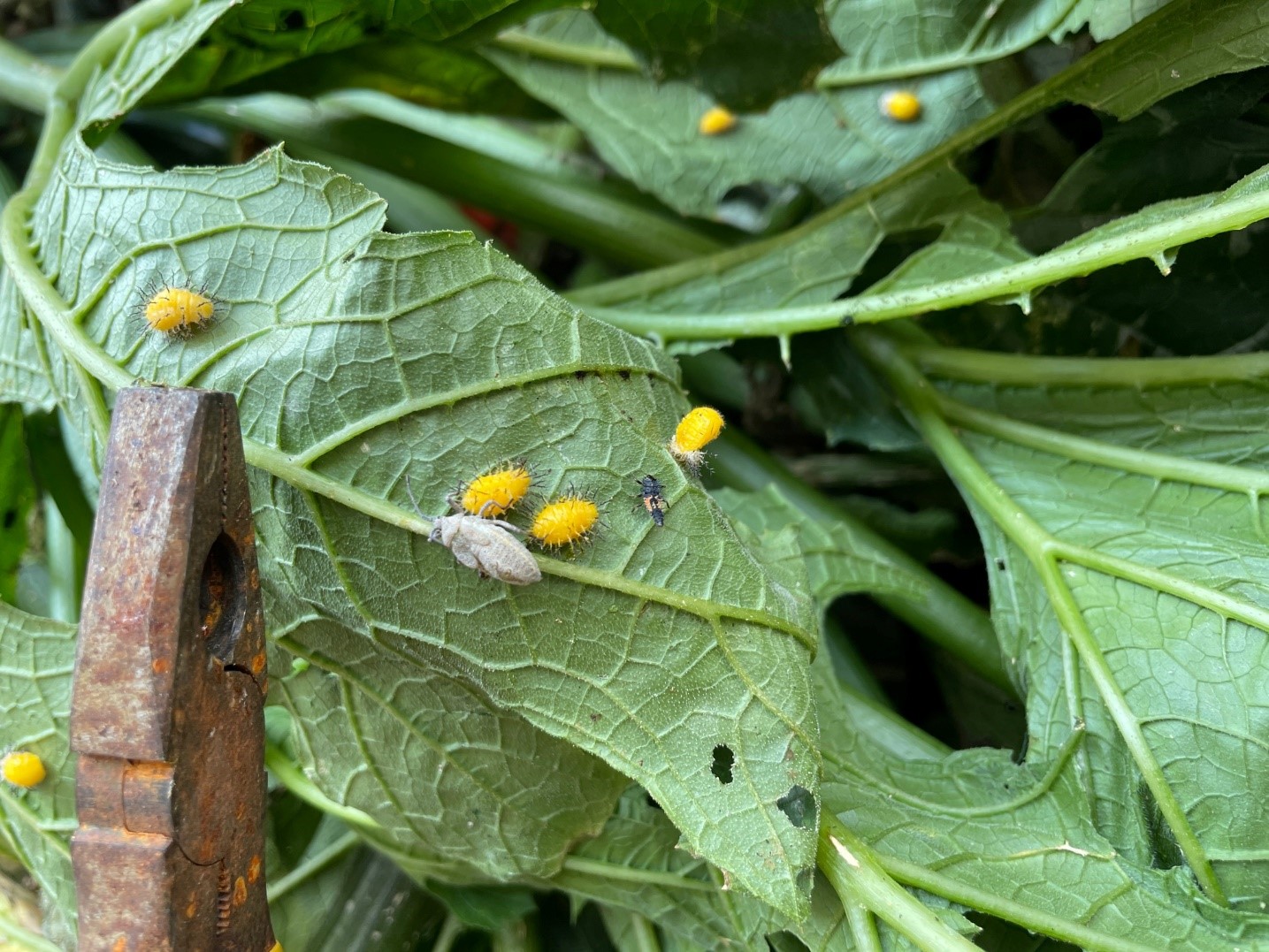
The good, the bad and the ugly otherwise known as ladybeetle larva, squash bug, and squash beetle larva. The ladybeetle larva does feed on the yellow spiky squash beetle larva. Unfortunately, neither of those wage war against the giant gray squash bug. These creatures were all over squash and zucchini plants that were removed because of powdery mildew and insect damage. Photo by B. Aly.
With biological insect control being one of our main research focuses this season, we have limited insecticide sprays to just Bt for control of tomato worm, tomato fruitworm, and army worm. Army worm seems to be the biggest pest at the moment, being observed in all four of the tunnels at DSAC. The additional predatory insect releases in the hydroponic tunnel have definitely made an impact on the pest insects, with a noticeable reduction in the spider mite populations across all of the crops. The cucumber and strawberry plants are sustaining healthy new growth that hasn’t been harmed by spider mite feeding. Dr. Athey will be presenting on this first year of biological insect control research at the 2022 Illinois Specialty Crops Conference this coming January.
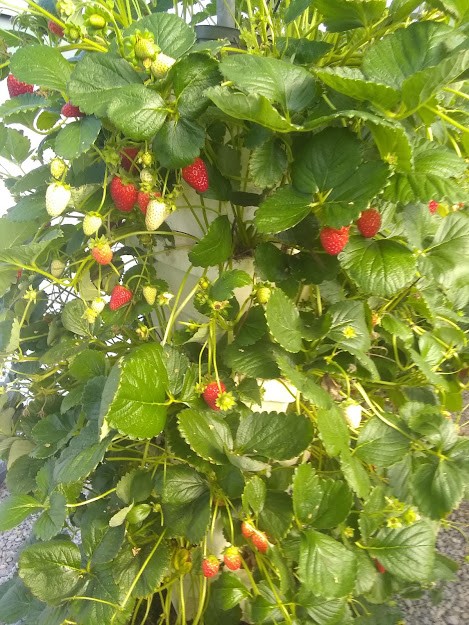
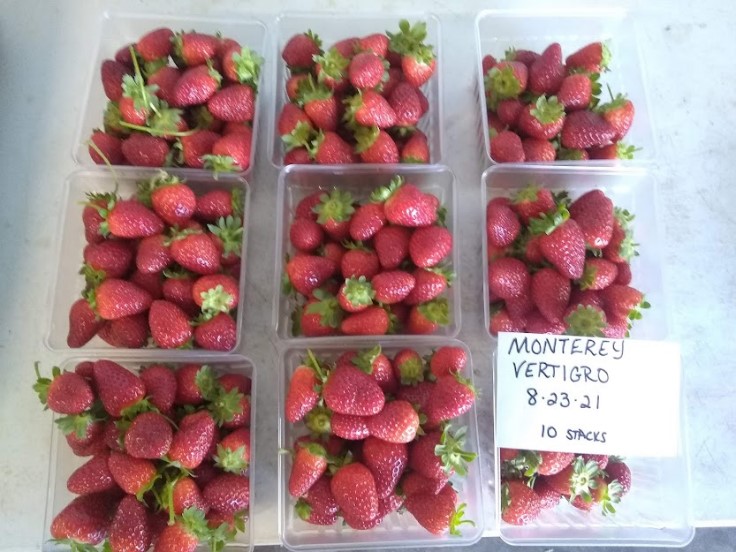
Left: Hydtroponic strawberries growing in vertical stacks at DSAC. Each stack is 5 containers high and contain a total of 20 plants/stack. Right: ‘Monterey’ strawberry variety has really picked up in production from earlier in the summer, with a harvest of almost 1 quart/stack. Photos by J. Zakes.
I am excited that my one ‘Pixie Crunch’ apple tree at home set a full crop and they are ready to harvest. I have been grabbing one each time I go by on the lawn mower and yesterday’s pass tasted great! I just need to get them harvested before the deer get them. My ‘Goldrush’ tree also set a good crop, needing quite a bit of thinning, and the fruit is sizing well but still several weeks away from harvest.

In the area at DSAC near our 4-H youth tunnel, we have set out our version of a “three sisters” planting that includes 3-4 ornamental corn varieties, several specialty pumpkins/gourds, and scarlet runner beans. This planting was established a bit late this season, but hopefully we will have enough time for the ornamental corn ears to finish out.
Photo by J. Zakes.
Bronwyn Aly (618-382-2662; baly@illinois.edu)
Fruit & Vegetable Production & Pest Management
Warm, Humid in the Midwest
The first two months of climatological summer were both warmer and wetter than the 1991-2020 normal statewide, although with some variability between northern and central/southern Illinois. Statewide total June to July rainfall was 13.44 inches, about 3 inches above the current normal and 15th wettest on record. While the first two months of the summer cracked the top 10 wettest on record in a few counties including Coles (9th wettest), Christian (8th wettest), and Wayne (8th wettest), it was also the 10th driest on record in Winnebago County.
With just two weeks left to go in climatological summer, total precipitation so far has ranged from nearly 20 inches in parts of central and south-central Illinois to less than 8 inches in northwest Illinois. Most areas north of Interstate 80 have had between 1 and 5 inches below normal rainfall since June 1st, while areas south of I-80 are 2 to 8 inches above normal over the same period.
Both June and July were warmer than normal, with a combined statewide average temperature of 74.4 degrees, about 1 degree above the 30-year normal. Summer to date temperatures have been between 1 and 2 degrees warmer than normal in northern and north-central Illinois, and within 1 degree of normal in southern and south-central Illinois. Although daily maximum temperatures across the state this summer have not frequently surpassed the low to mid 90s, humidity has been very high thanks to persistent, wide open southerly flow off the Gulf of Mexico. Many locations throughout the state have observed multiple days this summer with dew point temperatures exceeding 80 degrees, including 83 in Pontiac (Livingston County) and 82 in Decatur (Macon County) and in Alton (Madison County).
Looking ahead, the 3-month outlook for climatological Fall (September – November) is leaning into the likelihood of La Niña conditions returning to the Pacific in Fall. Strongest odds in the Fall outlooks are for above normal temperatures, with equal chances of above and below normal rainfall. Although there is quite a bit of variability between years, La Niña Fall seasons tend to be warmer and drier in Illinois.
Trent Ford, Illinois State Climatologist (217-244-1330; twford@illinois.edu)
EPA Issues Final Ruling on Use of Chlorpyrifos
Chlorpyrifos has been banned for use of fruit and vegetable crops. This will take full effect in six months. The trade name of chlorpyrifos used in fruit production is Lorsban. It is currently listed in the Midwest Fruit Pest Management Guide to control several pests in apples, peaches, and other tree fruits. The alternatives for some of our wood boring insects, pyrethroids like Mustang Maxx have been shown to have good efficacy on peach trees. Pyrethroids may work in apples for dogwood borer, but their efficacy is currently unknown. Insecticides labeled for use on borers in apple are Altacor, Assail, and Azera.
https://www.epa.gov/newsreleases/epa-takes-action-address-risk-chlorpyrifos-and-protect-childrens-health
Kacie Athey (217-244-9916; kathey@illinois.edu)
Less Seriously
I have been seeing more and more memes and postings on social media with the corny “dad jokes”, and I have to say, they really do make me laugh. I think they are a great distraction from all the divisiveness surrounding us these days. But what I have been finding even more entertaining, are the jokes I am hearing from my 10 year old son. Those with older children probably remember the joke telling stage that hits just before the chaos of the pre-teen, while they are still mostly innocent but teetering on the edge of having some worldly knowledge. And those with younger kiddos, just wait, they are going to getting pretty darn funny (at least in their minds). Thought I would share a few of the jokes I have been told in the last week or so, and yes I am omitting any that involve flatulence which greatly narrowed the pool.
Hey Mom, what’s it called when you have to stop the car and let my annoying sister out?
- A pest stop
Hey Mom, what did the alien invader say to Orange (that’s our cat’s name)?
- Take me to your litter
And finally, this classic from Sunday morning. I walked into the kitchen and my son is very intently staring at a can of frozen orange juice. I asked, “Is something wrong with the orange juice? Why are you just staring at it? And he says, “Because it says concentrate”
University of Illinois Extension Specialists in Fruit and Vegetable Production & Pest Management
Extension Educators – Local Food Systems and Small Farms |
||
Bronwyn Aly, Gallatin, Hamilton, Hardin, Pope, Saline, and White counties |
618-382-2662 |
|
Katie Bell, Franklin, Jackson, Perry, Randolph, & Williamson counties |
618-687-1727 |
|
Sarah Farley, Lake & McHenry counties |
847-223-8627 |
|
Nick Frillman, Woodford, Livingston, & McLean counties |
309-663-8306 |
|
Laurie George, Bond, Clinton, Jefferson, Marion, & Washington counties |
618-548-1446 |
|
Zachary Grant, Cook County | 708-679-6889 | |
Doug Gucker, DeWitt, Macon, and Piatt counties |
217-877-6042 |
|
Erin Harper, Champaign, Ford, Iroquois, and Vermillion counties |
217-333-7672 |
|
Grace Margherio, Jackie Joyner-Kersee Center, St. Clair County |
217-244-3547 |
|
Grant McCarty, Jo Daviess, Stephenson, and Winnebago counties |
815-235-4125 |
|
Katie Parker, Adams, Brown, Hancock, Pike and Schuyler counties |
217-223-8380 |
|
Kathryn Pereira, Cook County |
773-233-2900 |
|
James Theuri, Grundy, Kankakee, and Will counties |
815-933-8337 |
|
Extension Educators – Horticulture |
||
Chris Enroth, Henderson, Knox, McDonough, and Warren counties |
309-837-3939 |
|
Richard Hentschel, DuPage, Kane, and Kendall counties |
630-584-6166 |
|
Andrew Holsinger, Christian, Jersey, Macoupin, & Montgomery counties |
217-532-3941 |
|
Extension Educators - Commercial Agriculture |
||
Elizabeth Wahle, Fruit & Vegetable Production |
618-344-4230 |
|
Nathan Johanning, Madison, Monroe & St. Clair counties |
618-939-3434 |
|
Campus-based Extension Specialists |
||
Kacie Athey, Entomology |
217-244-9916 |
|
Mohammad Babadoost, Plant Pathology |
217-333-1523 |
|